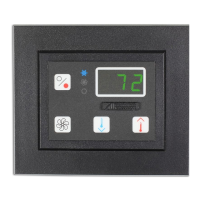Passport I/O Control Operations Manual Modes of Operation
L-2231 ENGLISH 5
codes. When the control resumes operation after a power interruption, "888" appears in the display and all the LEDs
light for one second. This is normal Power-On Reset operation.
BUTTON FUNCTIONS - SINGLE
• Power button - Press and release to toggle between the On and Off Modes.
• Up button - Press and release to display the set point. Press and hold the Up button to increase the set point. Set
point increases one degree each time the button is pressed.
• Down button - Press and release to display the set point. Press and hold the Down button to decrease the set point.
Set point decreases one degree each time the button is pressed.
• Fan button - Press to advance through the available fan settings. One through six indicates Manual Fan Speeds. One
is the lowest fan speed and six is the highest fan speed. The letter “A” displays when automatic fan operation is
selected.
BUTTON FUNCTIONS - DUAL
• Up & Down buttons (On Mode) - Simultaneously press the Up and Down buttons while in the On Mode to display
outside air temperature (if the optional outside air temperature sensor is installed).
• Up & Down buttons (Program Mode) - Simultaneously press the Up and Down buttons while in the Program Mode to
set new program defaults.
• Power & Down buttons (On Mode) - Simultaneously press the Power and Down buttons while in the On Mode to
enter the Moisture Mode.
• Power & Down buttons (Fault History) - Simultaneously press the Power and Down buttons while viewing the
service fault history log to clear the fault history log.
• Power & Up buttons (On Mode) - Simultaneously press the Power and Up buttons to view the service sensor
temperature (P-9 must be turned on).
• Fan & Down buttons (On Mode) - Simultaneously press the Fan and Down buttons to blank the display.
SPECIAL BUTTON FUNCTIONS
To implement these special functions, disconnect AC power, then press and hold the specified button while reconnecting AC
power.
• Service-History Log - With power to the unit disconnected, press and hold the Fan button while reconnecting the AC
power to view the service history log. Press the Power button once to exit the service history log. See “Service History
Log” on page 17 for details.
• Self-Test Mode - With power to the unit disconnected, press and hold the Power button while reconnecting the AC
power to enter the Self Test Mode. Use the self test to diagnose problems and test the air conditioning system. See
“Automated Factory Self-Test Program” on page 16 for details.
• View Hour Meter - With power to the unit disconnected, press and hold the Down button while reconnecting the AC
power to view the compressor hour meter. Maximum recordable time is 65,536 hours. See “Hour Meter” on page 17 for
details.
MODES OF OPERATION
OFF MODE
When the control is in Off Mode, all control outputs are turned off. Program parameters and user settings are saved in
nonvolatile memory. The Program Mode can only be accessed from the Off Mode.
ON MODE
When the control is in On Mode, power is supplied to the appropriate outputs and the display indicates the current state of
operation. The operating and program parameters resume based on those last stored when the unit was operating.
AUTOMATIC MODE
When Automatic Mode is selected, the system provides both heating and cooling as required. The Heat LED or Cool LED lights
indicate the mode in use. Cabin temperature in a given mode is maintained within 2°F (1.1°C) of set point. If the system was
most recently cooling, the cabin temperature must drop below the set point by at least 4°F (2.2°C) in order for the system to
switch from cooling to heating. Similarly, if the system was most recently heating, the cabin temperature must exceed the set
point by at least 4°F (2.2°C) in order for the system to switch from heating to cooling. This behavior prevents small temperature
overshoots from causing the system to switch between heating and cooling when it is not necessary. To make the temperature
differential between cooling and heating larger, see See “P-23: Auto Mode Heat Differential” on page 10.

